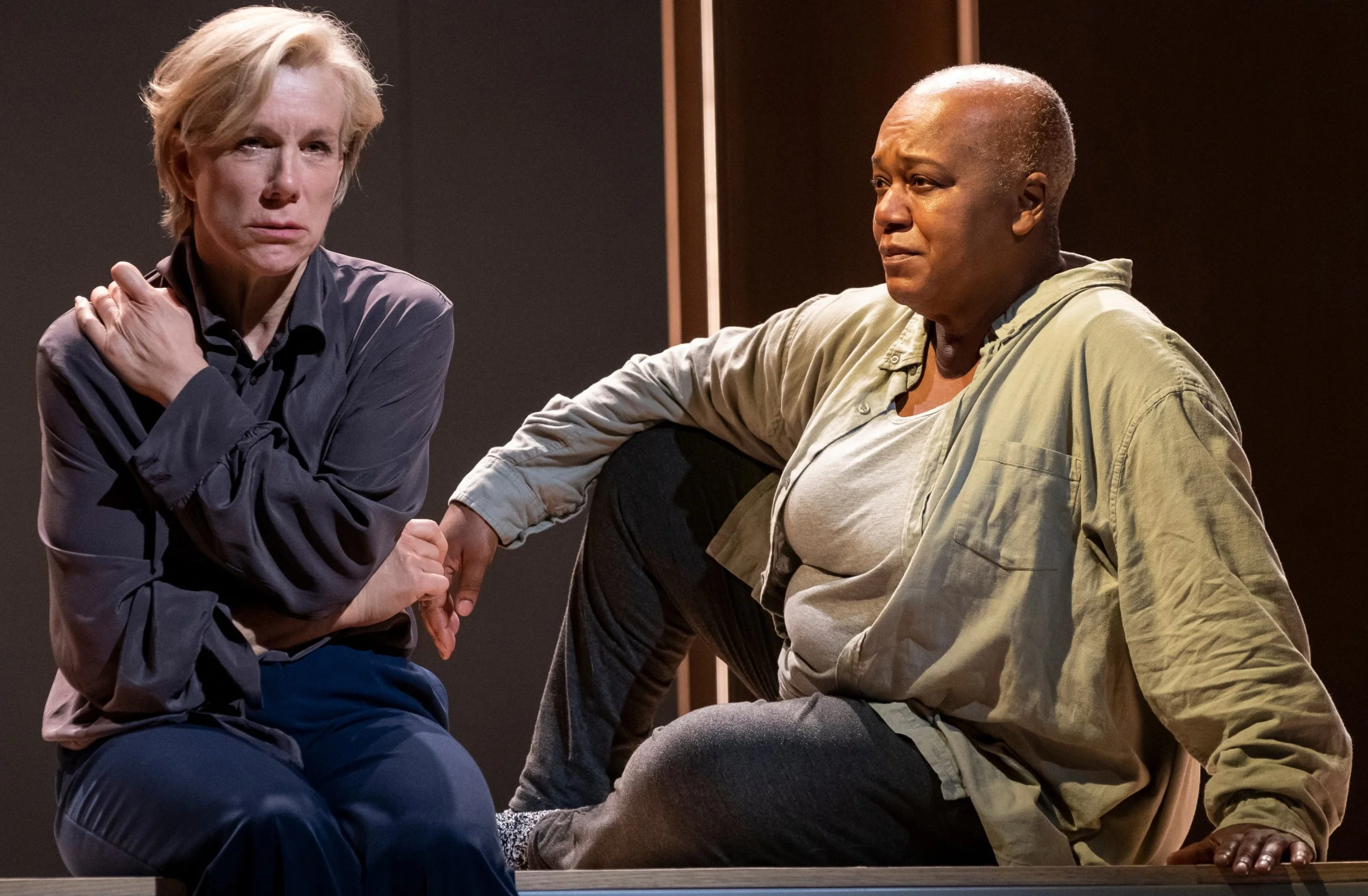Juliet Stevenson (left) plays Ruth Wolff, a physician under attack in Robert Icke’s The Doctor, and Juliet Garricks plays her partner Charlie.
Opportunities to see the British actress Juliet Stevenson on this side of the Atlantic are too rare to pass up. Robert Icke’s play The Doctor—Stevenson has the title role in this loose adaptation of Arthur Schnitzler’s Professor Bernhardi—is a welcome reminder of this actress’s enormous talent. It’s unmissable for any theater lover.
Stevenson plays Ruth Wolff, a hard-charging physician and founder of an institute for dementia research. She’s the kind of person whose punctiliousness leads her to criticize the misuse of language, such as literally and figuratively, with inordinate passion. In a rare move, she has taken in a young patient who lies dying of sepsis. When a priest sent by the girl’s family arrives to administer last rites, Ruth refuses him admission. The patient’s chart shows no religious affiliation. The confrontation ends with physical interaction—in director Icke’s production it is stylized ambiguously, with the help of lighting designer Natasha Chivers and sound designer Tom Gibbons—that sparks a boardroom and public relations crisis for the institute, which is seeking funding for a new building.
Jaime Schwarz (right) as Junior demands Ruth’s badge after her resignation. Photographs by Stephanie Berger Photography.
Few playwrights other than David Hare willingly take up social institutions for examination, so Icke deserves kudos. Ruth faces a rivalry from the institute’s cofounder, Roger Hardiman (Naomi Wirthner), a Catholic who disagrees with Ruth’s behavior toward the priest, and other doctors jump in (slashes in the script indicate overspeaking):
Roberts: Was she a Christian?
Murphy: (chorus) Yes.
Copley: (chorus) No.
Hardiman: (chorus) Well–
Murphy: She was wearing a crucifix.
Copley: That’s a generational thing, loads of young / people
Murphy: when she died, she was wearing / a crucifix
Ruth: Exactly. We don’t know. We will now never know. Her parents were Catholics
Hardiman: are Catholics.
Copley: But the point is a single case cannot be blown up into a symbolic campaign / against religion.
Hardiman: Yes it can. Yes it can.
As the arguments whiz by at top speed, the dramatic stakes are deeply engaging. When one board member tries to suggest that Ruth is religious, she demurs: “My parents were Jewish. They were religious people: I am not.” By the end, however, a swastika has been painted on her car.
Icke charts Ruth’s downfall as she tries to hold the board together amid a contemporary witches’ brew of identity politics, religion, science, virtue signaling and social media. She becomes the centerpiece of a virulent religion vs. science debate.
John Mackay (left), as the irate father of a young woman who has died, faces off with Doña Croll
as Dr. Brian Cyprian, who is concerned with
fund-raising.
Simultaneously, however, Icke creates obstacles for the viewer. Almost all the actors are playing roles that do not correspond to their race or gender—although they are all superb. The audience must listen closely to discover the correlations. Wirthner, a black woman, plays Roger Hardiman, a man; another black woman, Doña Croll, plays Brian Cyprian, head of development; and John Mackay, a tall white man who plays the spurned priest, is revealed to be black. There’s an underlying reason for the herky-jerky mishmash, since identity politics underlie the conflicts, but such revelations repeatedly disengage a viewer trying to figure out who is who on this express train of ideas. It proves more irritating than enlightening.
Confident in her mastery of language, and against Charlie’s advice, Ruth accepts an invitation to a TV show called Take the Debate. Ruth is interrogated by a panel of five people, who, for the first time, play their actual race and gender. It’s a contrast that, one may feel, renders the scene even more powerful as Ruth’s attackers prove unscrupulous in twisting emotions.
Ruth: For a doctor, language is precise—a diagnosis has to be specific.
Five: So—what? You’re discounting a whole history, a whole system of ideas, because you don’t like the nasty word woke? Woke is an attempt—and an honest attempt—to create a consciousness of people who aren’t like you. … It’s so upsetting that you won’t understand, you think you’re above what we’re saying to you.
During the sequence Stevenson sits facing upstage, with her face projected in a triptych on the curved walls of Hildegard Bechtler’s set, and in every slight quaver of her lip or in the flicker of an eyelid, one can see Ruth’s composure falter.
Ruth’s personal life is dragged in as well: on TV she inadvertently misuses language to describe Sami (Matilda Tucker), a teenager struggling with gender identity whom she mentors, which ends their relationship. By the end of this thought-provoking drama, Ruth becomes a major tragic figure, as honesty and competence, and the people who believe in them, are ground down for political gain. It’s a scathing view of the current state of democracy.
The Doctor plays through Aug. 19 at the Park Avenue Armory (643 Park Ave., between 66th and 67th streets). Evening performances are at 7 p.m. Monday through Thursday and at 8 p.m. Friday and Saturday; matinees are at 2 p.m. Saturdays. For tickets and information call (212) 933-5812 or visit armoryonpark.org.





